AEG-Electrolux FAV448, FAVORIT44630, F44630 User Manual

FAVORIT 44630
Dishwasher
Operating instructions
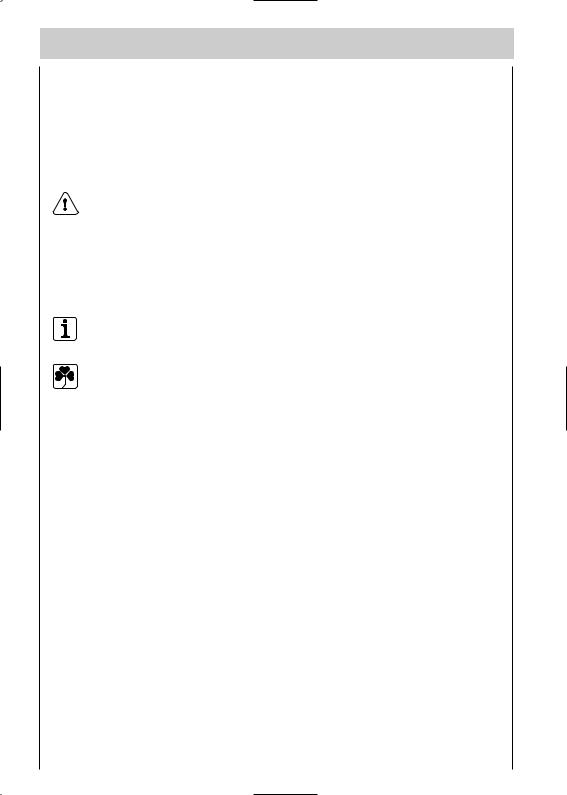
Dear customer
Please read these user instructions carefully.
Above all please observe the safety instructions on the first few pages of these user instructions! Please keep these user instructions for later reference. Pass them on to any subsequent owner of the appliance.
The warning triangle and/or specific words (Warning!, Caution!, Important!) are used to highlight instructions that are important for your safety or for the function of the appliance. It is imperative that these instructions are observed.
Numbered instruction steps lead you step by step through the operation of the appliance.
Next to this symbol you receive additional information and practical tips on using the appliance.
Tips and instructions for the economical and environmentally conscious use of the appliance are marked with a clover leaf.
In the event of a malfunction, these operating instructions contain information on how to rectify faults yourself, see "Something not working" section.
For further assistance contact your local AEG Service Force Centre, see the chapter "Service & Spare Parts".
Printed on paper manufactured with environmentally sound processes.
He who thinks ecologically acts accordingly...
2

Contents
Safety instructions |
4 |
Disposing of packaging and old machines |
5 |
Disposing of the packaging |
5 |
Disposing of your old machine |
6 |
Economical and ecological dishwashing |
6 |
Description of the appliance |
7 |
The inside of the appliance |
7 |
Control panel |
8 |
Before using your dishwasher for the first time |
9 |
Setting the water hardness range |
9 |
Filling with special salt |
11 |
The rinse aid |
12 |
Loading cutlery and dishes |
14 |
The lower basket |
15 |
Cutlery basket |
16 |
The upper basket |
16 |
Adjusting the height of the upper basket |
17 |
Use of detergent |
18 |
50°C programmes and compact powders |
19 |
Washing programmes |
20 |
Operating instructions |
22 |
Maintenance and cleaning |
25 |
Internal and external cleaning |
25 |
Cleaning the filters |
25 |
Something not working |
27 |
Service & Spare Parts |
29 |
Guarantee Conditions |
30 |
European Guarantee |
31 |
Hints for test centres |
32 |
Technical data |
33 |
Installation and connection instructions |
34 |
Fitting under a counter |
34 |
Levelling |
34 |
Connecting to the water supply |
35 |
Water outlet connection |
35 |
Extension hoses |
36 |
Water protection system |
36 |
Electrical connection |
37 |
3

 Safety instructions
Safety instructions
The safety of AEG electrical appliances conforms to accepted rules of technology and the Appliance Safety Act. We as manufacturers, however, see ourselves as being obliged to familiarise you with the following safety instructions.
Using your dishwasher for its intended purpose
●Only use your dishwasher for machine washing of household crockery. If your machine is misused or used for any purposes other than that for which it is intended, the manufacturer cannot be held liable for any damage caused.
●For safety reasons, you should not convert or modify your dishwasher in any way.
Before using your dishwasher for the first time
●Check your dishwasher for any transport damage. Never connect a damaged machine. If your dishwasher is damaged, you should contact your supplier.
●Your dishwasher must be correctly installed and connected. Please read the section on "Installation" to make sure you know all about this.
●Before using your dishwasher for the first time, do not forget that the nominal voltage and current type indicated on the rating plate of your machine must be the same as the nominal voltage and current type at the installation site. The necessary electrical rating is also given on the rating plate.
Child safety
●Packaging parts (e.g. foils, styrene foam) may be dangerous for children, who could even be suffocated! You should therefore keep all packaging well away from children.
●Children may not recognise the dangers of improper use of electrical appliances. You should therefore ensure proper supervision during operation and not allow your children to play with your dishwasher.
●Detergents may have a caustic effect on eyes, mouth and throat and may even cause suffocation! Keep all detergents in a safe place out of children’s reach.
●The water in your dishwasher should not be used for drinking. Detergent residues may still be present in your machine. Keep children well away from your dishwasher when its door is open.
Your dishwasher in day-to-day use
●Never operate your dishwasher if the electrical supply lead, supply or drainhose, control panel, worktop or plinth are damaged.
●If there is a fault, first turn the water tap off. Then switch off your machine and pull the plug out of the socket. If there is a fixed connection, switch off or unscrew the fuse(s).
4
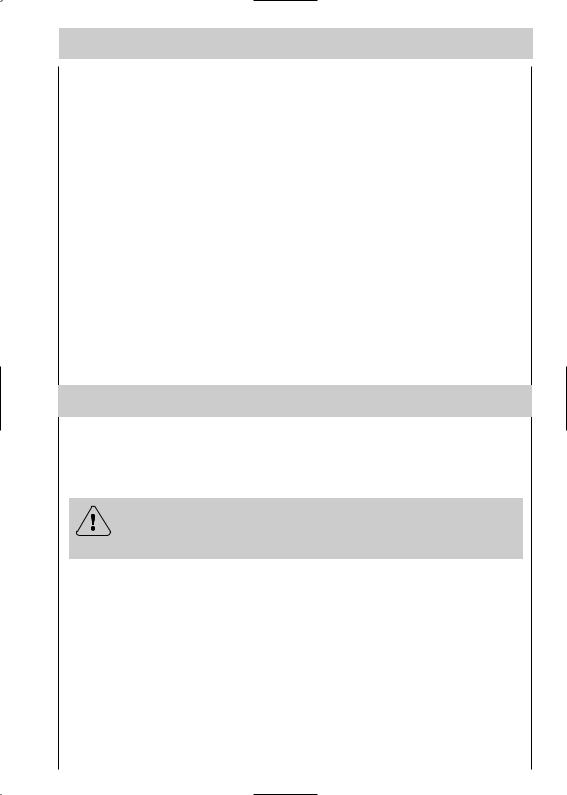
●Never pull the plug out of the socket by the cable - always hold the plug.
●Dishwasher repairs should only be performed by trained personnel. Improper repairs may seriously endanger the user. If your dishwasher needs to be repaired, you should contact your local AEG Service Force Centre or your retailer.
●Never place any solvents in your dishwasher or you may cause an explosion!
●Do not rest or sit on the open door as the machine could tilt.
●Before using special dishwasher salt, detergent or rinse-aid, make sure that the manufacturer of these products expressly specifies their use in domestic dishwashers.
●Always turn off the water tap when your dishwasher is left unattended for any length of time, e.g. when you are away on holiday.
●Only transport the dishwasher in an upright position. Tipping it upside down during transport could cause salty water to leak into the internal compartment and lead to the formation of rust.
Disposing of packaging and old machines
Disposing of the packaging
Our dishwashers require effective protective packaging in transit, though we always confine ourselves to what is absolutely necessary.
Warning! Packaging parts (e.g. foils, styrene foam) may be dangerous for children and can cause suffocation. You should therefore keep all packaging well away from children.
All packaging materials used are environmentally compatible and reusable.
The cardboard parts are produced from recycled paper, and the wood is untreated.
The plastics are marked as follows:
>PE< |
for polyethylene, e.g. packaging foils. |
>PS< |
for polystyrene, e.g. padding (essentially CFC-Free). |
>POM< |
for polyoxymethylene, e.g. plastic clamps. |
Give the packaging for reuse to your local recycling centre. Your municipal or local authority will give you its address.
5
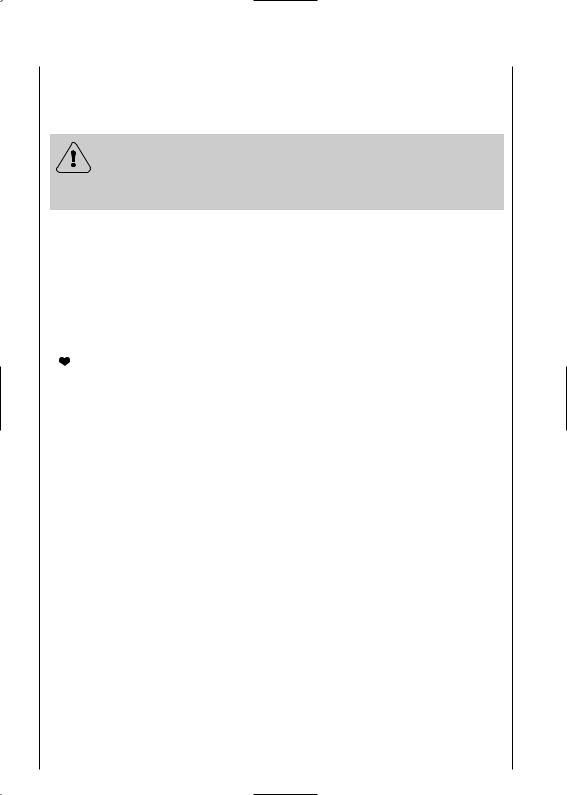
Disposing of your old machine
When your machine finally reaches the end of its life and you withdraw it from service, you should render it unserviceable before having it disposed of.
Warning! Children at play could lock themselves in your machine (and suffocate) or otherwise endanger their lives. Therefore pull out the main plug and detach and discard the electrical supply lead.
Disable the door lock so that the door no longer closes.
Marking of plastic parts for graded recycling: all plastic parts in your machine are marked with internationally standardised abbreviations (e.g. <PS> for polystyrene). When your machine is disposed of, this enables plastic waste to be sorted into individual types for environmentally conscious recycling.
Check with your local Council or Environmental Health Office to see if there are facilities in your area for recycling the appliance.
 Economical and ecological dishwashing
Economical and ecological dishwashing
●Ensure that the water softener is correctly adjusted.
●Do not pre-rinse under running water.
●Select the wash programme to suit the nature and degree of the soiling on the dishes.
●Do not use more detergent, special salt or rinse aid than is recommended in these operating instructions and by the manufacturer of the respective product.
6
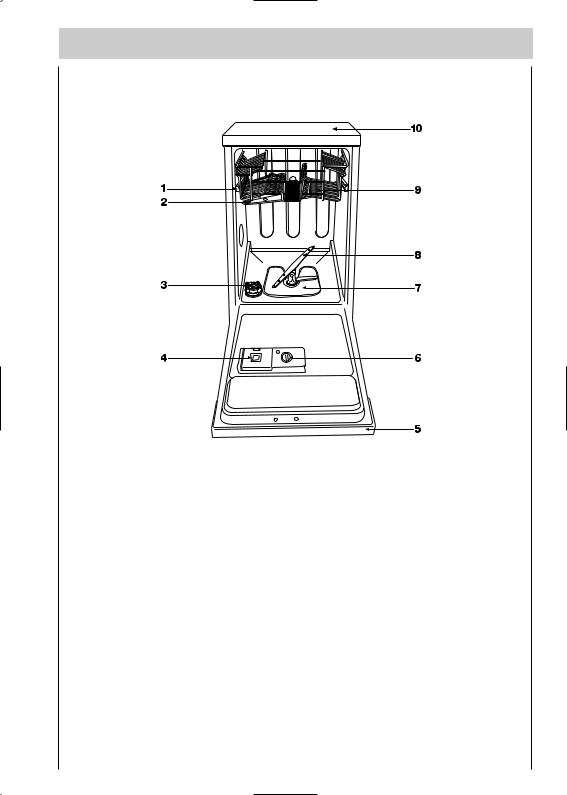
Description of the appliance
The inside of the appliance
IN111
1.Upper basket stop
2.Upper spray arm
3.Salt container
4.Detergent dispenser
5.Control panel
6.Rinse aid dispenser
7.Filters
8.Lower spray arm
9.Upper basket
10.Worktop
7
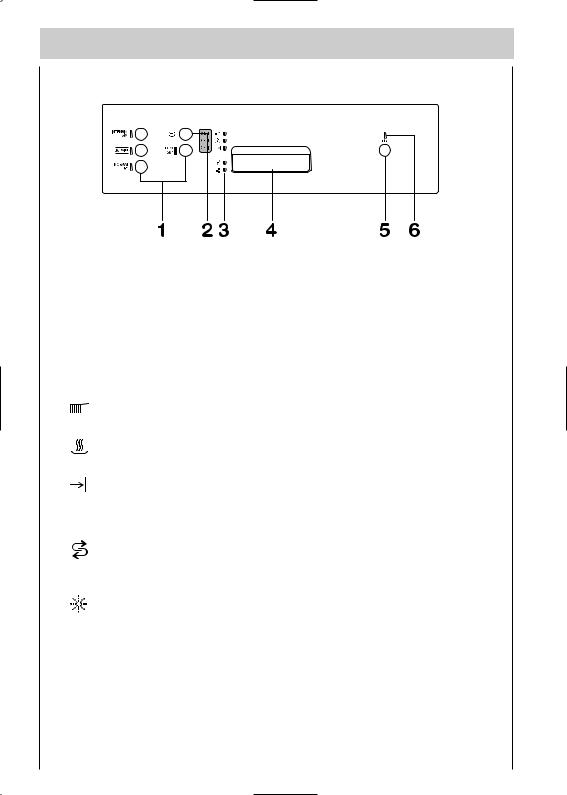
Control panel
1.Programme selector push buttons
2.“Delay start” push button
This option allows the start of the programme to be delayed by 3, 6 or 9 hours.
3. Indicator lights
Phase indicator lights
washing phase
illuminates when the washing phase is running
drying phase
illuminates when the drying phase is running
end of programme
illuminates when the washing programme has ended
Salt and rinse aid indicator lights
salt refilling indicator light
illuminates when the salt has run out and the salt container requires refilling.
rinse aid refilling indicator light
illuminates when the rinse aid has run out and the rinse aid container requires refilling.
4.Door handle
5.On/Off push button
6.On/Off indicator light
8

Before using your dishwasher for the first time
1.Ensure that the electrical and water connections comply with the installation instructions.
2.Remove all packaging from inside the appliance.
3.Set the water softener.
4.Pour 1 litre of water inside the salt container and then fill with salt.
5.Fill the rinse-aid dispenser.
Setting the water hardness range
The dishwasher is equipped with a water softener designed to remove minerals and salts from the water supply, which would have a detrimental or adverse effect on the operation of the appliance.
The higher the content of these salts, the harder your water is.
Water hardness is measured in equivalent scales, German, French degrees and PPM (parts per Million).
The softener should be adjusted according to the hardness of the water in your area. Your local Water Authority can advise you on the hardness of the water in your area.
The dishwasher is factory set at level 3.
If this level is not suitable for your area the softener should be adjusted.
Level |
|
|
|
Water hardness |
|
|
Use of salt |
||
|
|
|
|
|
|
|
|
||
Clarke |
|
°TH |
|
|
PPM |
||||
|
|
|
|
|
|
|
|||
|
|
degrees |
|
(french degrees) |
|
|
(parts per million) |
|
|
|
|
|
|
|
|
|
|
|
|
1 |
|
< 6 |
|
< 8 |
|
|
< 80 |
|
NO |
2 |
|
6 - 21 |
|
8 - 30 |
|
|
80 - 300 |
|
YES |
3 |
|
22 - 35 |
|
31 - 50 |
|
|
301 - 500 |
|
YES |
4 |
|
36 - 49 |
|
51 - 70 |
|
|
501 - 700 |
|
YES |
5 |
|
50 - 63 |
|
71 - 90 |
|
|
701 - 900 |
|
YES |
|
|
|
|
|
|
|
|
|
|
If your water is level 1 it is already soft and therefore there is no need to use salt. With the setting of the water softener at level 1 the salt indicator light on the control panel will always remain off.
Use salt from level 2 upwards.
From level 2 upwards, if salt refilling is necessary, the salt indicator light will illuminate only in setting mode and at the end of the washing programme. While the programme is running it will remain off.
9
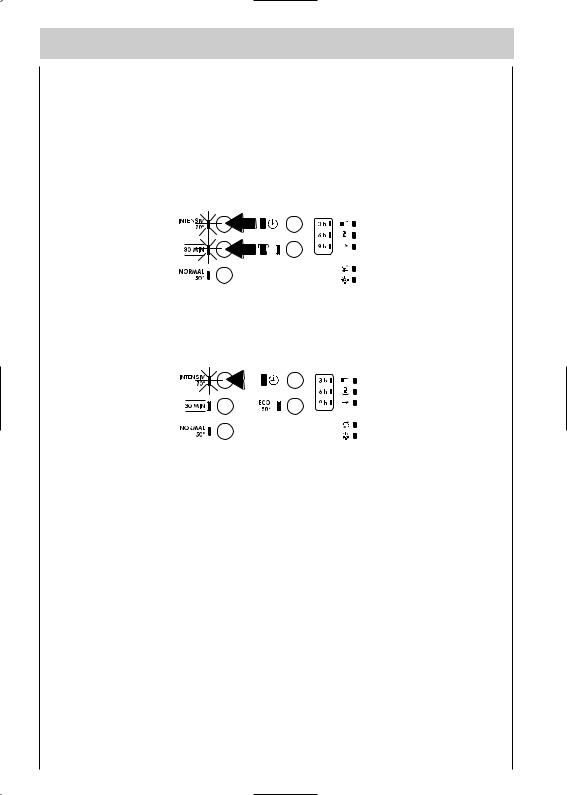
To select a different level be sure that the dishwasher is off and then proceed as follows:
1.Press INTENSIV 70° and 30 MIN programme push buttons simultaneously.
2.While keeping the programme push buttons INTENSIV 70° and 30 MIN pressed switch on the dishwasher by pressing the On/Off push button. The On/Off indicator light comes on. At the same time, the indicator lights of the INTENSIV 70° and 30 MIN push buttons start flashing.
SO449
Press the INTENSIV 70° push button, the indicator light of the 30 MIN push button turns off, while the indicator light of the INTENSIV 70° push button remains static for about 5 seconds and then starts to flash indicating the current level.
SO450
The current level is indicated by the number of flashes made by the INTENSIV 70° indicator light, that alternates 5 seconds off with a number of flashes, this continues for about 60 seconds.
Example: |
|
|
1 flash |
= |
level 1 |
2 flashes |
= |
level 2 |
3 flashes |
= |
level 3 |
4 flashes |
= |
level 4 |
5 flashes |
= |
level 5 |
3.To change the level, press the INTENSIV 70° programme push button. Each time the push button is pressed the level changes.
Examples:
If the current level is 3, by pressing the INTENSIV 70° programme push button once, level 4 is selected.
If the current level is 5, by pressing the INTENSIV 70° programme push button once, level 1 is selected.
The INTENSIV 70° indicator light remains off for about 5 seconds after which it starts flashing indicating the new level selected.
10
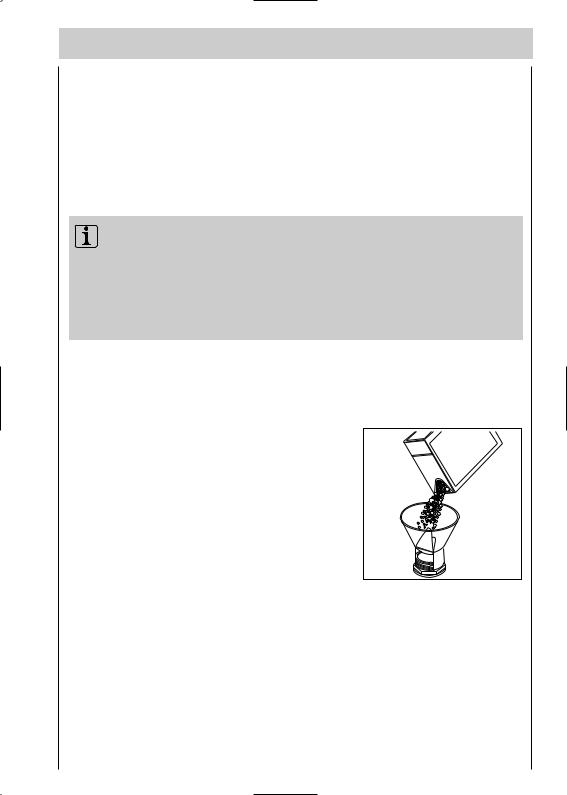
4.To memorise the new level, switch off the dishwasher by pressing the On/Off push button.
Filling with special salt
Caution! The packaging of dishwasher salt and detergents are often very similar. The accidental filling of the salt compartment with detergent would ruin the water softener. Each time you add salt, make sure the carton you have in your hand really is salt.
Only use salt specifically designed for use in dishwashers.
All other types of salt not specifically designed for use in a dishwasher, especially table salt, will damage the water softener.
Only fill with salt just before starting one of the complete washing programmes. This will prevent any grains of salt or salty water, which may have been spilled, remaining on the bottom of the machine for any period of time, which may cause corrosion.
To fill: |
|
|
|
|
1. To fill with salt, unscrew the cap of the salt container. |
|
|
|
|
2. Pour 1 litre of water inside the container (this is necessary only before |
||||
filling with salt for the first time). |
|
|
|
|
3. Using the funnel provided, pour in the salt until |
|
L |
|
|
|
|
|
E |
|
|
A |
T |
||
the container is full. |
S |
|
||
|
|
L |
||
|
S |
L |
||
|
|
|
A |
Z |
Do not worry if water overflows from the unit |
|
|
A |
|
|
|
S |
L |
|
|
|
|
SE |
|
when filling with salt, this is quite normal. |
|
|
|
|
4. Replace the cap making sure that there is no trace of salt on the screw thread or on the gasket.
5. Screw on the cap tightly. |
SR14 |
When this has been done, all that is required is to periodically top up the container with salt.
You are reminded of this by the salt indicator light on the control panel which will illuminate when the salt has finished.
Important!
The salt refill indicator light on the control panel can remain illuminated for 2-6 hours after salt has been replenished, assuming the dishwasher remains on. If you are using salts that take longer to dissolve then this can take longer, the function of the
dishwasher is not affected.
11
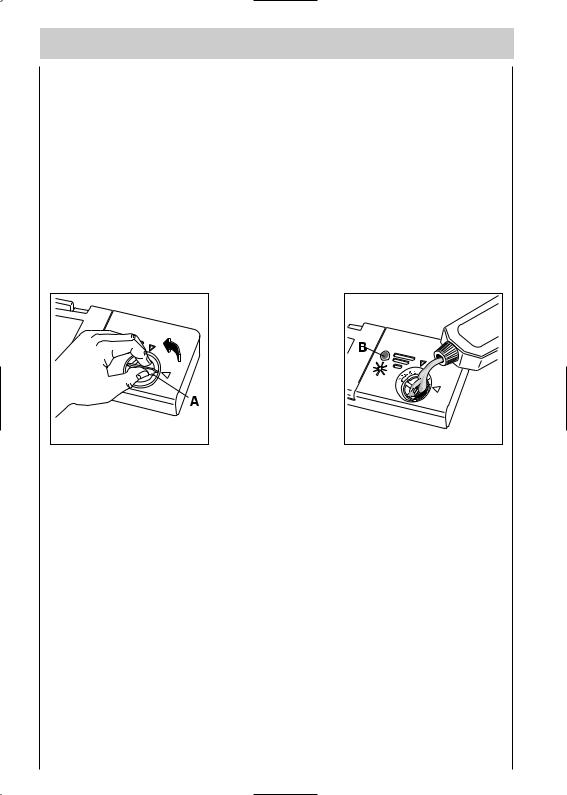
The rinse-aid
The rinse-aid ensures brilliant crockery and also helps it to dry. It is automatically dosed in during the hot rinsing cycle. The storage compartment built in to the inside of the door can hold about 110 ml of rinse-aid, which will be sufficient for between 16 and 40 dishwashing programmes, according to the dosage setting.
Filling up the rinse-aid
1.Open the container by turning the lid (A) anticlockwise.
2.Add the rinse aid until the container is completely full. The indicator (B) will be completely dark.
3.Top up the rinse aid when the rinse aid indicator light on the control panel illuminates.
BR01 |
BR03 |
Ensure that the lid is closed after every refill.
Clean up any rinse aid spilt during filling with an absorbent cloth to avoid excess foaming during the next wash.
Attention! Do not put liquid detergent in the rinse aid compartment.
If rinse aid refilling is necessary, the rinse aid indicator light will illuminate only in setting mode and at the end of the washing programme.
During the run of the programme it will remain off.
It is possible to deactivate the rinse aid indicator light (see the following instructions).
By default the rinse aid indicator light is active.
12
